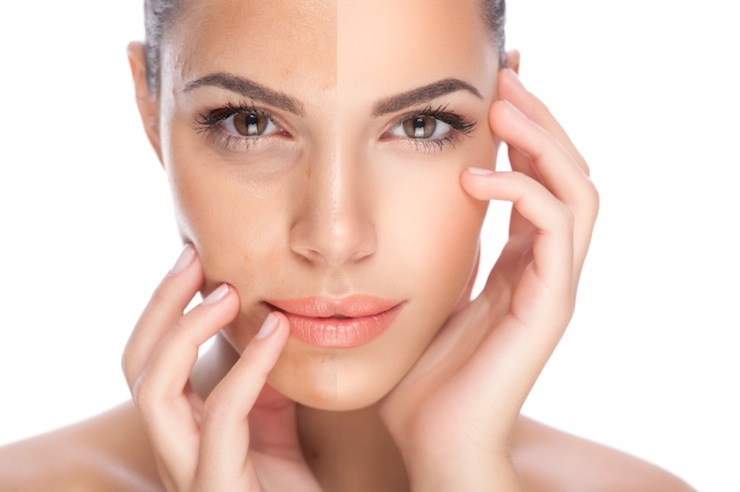The skin is the largest organ of the human body, but what is surprising is that most people forget to take care of it. For most people, their skin routine is focused solely on their face – they will wash their face, use expensive products and treat them to facials and masks. At the most, people might pay a little attention to their hands, by protecting them against sunlight and applying sunscreen. However, for most people their care regime of their skin stops there, which is why conditions such as hyperpigmentation and even wrinkles often start to appear. While wrinkles are inevitable and will start to appear with age, hyperpigmentation is a condition that is often invited by not giving the body the care that it deserves.
Let’s look at everything associated with hyperpigmentation:
Hyperpigmentation is a condition which is caused by the excessive production of melanin in the body, leading to dark spots. Age spots, sun spots, liver spots and even freckles are all types of hyperpigmentation. In most cases, hyperpigmentation is not a lethal condition, but if you are suddenly noticing dark spots, you might want to consult a doctor. The main causes of the condition include over exposure to the sun, hormonal changes, skin treatments gone wrong, acne and at times, heredity. When your skin is exposed to the UV rays of the sun, there is an inflammation in the skin and when there is too much exposure and inflammation, you will start to notice spots developing.
 Your skin is actually quite delicate and something like a cut or acne can cause an excess of melanin production. When the melanin production goes up, it can lead to hyperpigmentation, because the skin is unable to generate the natural skin pigments. Even if you have any allergic reaction, to perhaps something like poison ivy or any chemical products, you could develop hyperpigmentation as a result, because even allergies will lead to inflammation. When there is a change in the natural hormonal levels in the body, there can be hyperpigmentation. For instance, if there is a rise in the progesterone or oestrogen levels in the body, there will be an increase in the production of melanin, which can cause hyperpigmentation. In the case of certain people, hyperpigmentation is genetic, and although it can skip generations, if the condition is in your genes, chances are that it will emerge at some point.
Your skin is actually quite delicate and something like a cut or acne can cause an excess of melanin production. When the melanin production goes up, it can lead to hyperpigmentation, because the skin is unable to generate the natural skin pigments. Even if you have any allergic reaction, to perhaps something like poison ivy or any chemical products, you could develop hyperpigmentation as a result, because even allergies will lead to inflammation. When there is a change in the natural hormonal levels in the body, there can be hyperpigmentation. For instance, if there is a rise in the progesterone or oestrogen levels in the body, there will be an increase in the production of melanin, which can cause hyperpigmentation. In the case of certain people, hyperpigmentation is genetic, and although it can skip generations, if the condition is in your genes, chances are that it will emerge at some point.
There are also some medications that can cause hyperpigmentation as a side effect – certain antibiotics, topical retinoids, hormonal medicines and chemotherapy drugs are known to lead to this condition. While threading and shaving will not need to hyperpigmentation, tweezing, waxing and hair removal creams can – when your hair is being removed from the root, it can get inflamed and that inflammation could lead to hyperpigmentation.
Here are some of the best methods to treat hyperpigmentation:
- You can try home remedies such as aloevera or vitamin E to treat the condition.
- Applying natural ingredients such as lime, raw potato juice, lemon juice mixed with honey or basil leaves are all known to work.
- There are topical and over the counter medications – ones that contain Retin-A or alpha hydroxy acid are known to work well. Hydroquinone, Kojic acid, Azelaic acid and Mandelic acid are all prescribed medications for hyperpigmentation, but make sure that yours is prescribed by a proper doctor.
- And then there are procedures that you could get done at a clinic such as a chemical peel or microdermabrasion. Both these procedures will simply peel away the top layer of the skin, revealing healthier skin right underneath.
Now, let’s move onto wrinkles – something that is inevitable, but can most certainly be delayed for a few years, if you take proper care. But let’s start with what wrinkles are and what causes them:
In the simplest of terms, wrinkles are creases or folds that form in the skin, and normally start to become visible with age. Although age is one of the biggest causes for wrinkles, they can also be caused by excessive exposure to the sun, dehydration, smoking, pollution and also some medications. When you are young and your skin is young, every time you move your facial muscles, the skin is able to bounce back. However, as the skin ages, this ability of the skin to bounce back starts to reduce and that is the start of the formation of wrinkles. The ability of the skin to spring back also reduces because the body is not able to produce enough collagen.
Even though wrinkles will appear for every human being, there are methods by which the inevitable can be pushed for a few more years. Here are some of the most commonly used methods to treat wrinkles:
- Should you talk to your doctor about wrinkles, they might be able to prescribe medication that will help. These could include topical retinoids, which are based on vitamin A as well as over the counter anti-wrinkle creams. Topical solutions containing alpha hydroxy acids, retinol, copper peptides, kinetin, coenzyme Q10 and antioxidants.
- There are several procedures that are offered by cosmetology clinics, many of which are extremely effective and Botox and dermal fillers top the list. These are injectable medications, which will immediately fill in lines and creases, giving your skin a fuller look.
- In the recent past, laser therapy has become extremely popular for people looking to smoothen out their skin and get rid of the wrinkles and fine lines, without any invasive methods. The laser is directed on the skin and it penetrates to stimulate the collagen. Once the collagen is activated, the skin looks plumper and younger.
- Then there procedures such as dermabrasion and chemical peels, which are not invasive, but will scrub or peel away the top layer of the skin, revealing younger skin underneath. What these procedures also do is that they push the skin to heal it on its own, and the new skin that emerges is normally better.
- In the most extreme situations, people might consider a surgical facelift, in which the skin is literally lifted and tucked in, to give a tighter appearance.
No matter which approach you are considering, it is imperative that you talk to a doctor first, get your skin checked and then choose a method that the doctor suggests.
Guest Blogger
 Dr. Aman Dua, MBBS MD, skilled dermatologist & hair transplant surgeon and co-founder of AK Clinics. She had practiced both medical and dermatology for years. Exceptionally talented at treating skin conditions require laser therapy such as acne, scars, wrinkles, pigmentations or other treatments like facelift, chemical peels, anti-aging treatments.
Dr. Aman Dua, MBBS MD, skilled dermatologist & hair transplant surgeon and co-founder of AK Clinics. She had practiced both medical and dermatology for years. Exceptionally talented at treating skin conditions require laser therapy such as acne, scars, wrinkles, pigmentations or other treatments like facelift, chemical peels, anti-aging treatments.

